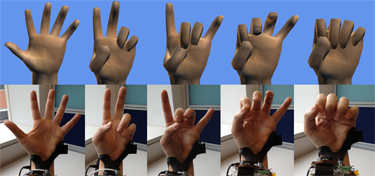Motion tracking and gesture controls have become common with the rollout of Microsoft Kinect and other sensor-based devices. But what if the sensors were on your wrist, not across the room?

Researchers from Microsoft, Newcastle University’s Culture Lab and Greece’s Foundation for Research & Technology have come up with a way to track the motion of a person’s hand and model it in three-dimensional space from an array of infrared sensors mounted on the wrist.
As demonstrated in the video above, the approach lets users move their hand through the air to zoom in and out of a tablet, control the invisible “dials” of a stereo system, and interact with a game, among many other possible applications.
All of this can happen pretty much anywhere, because the unit is self-contained on the wrist.
 Normally this type of setup would require the user to wear a sensor-laden glove.
Normally this type of setup would require the user to wear a sensor-laden glove.
They call the project “Digits.” Right now, the prototype is bulky enough to get some very odd looks from people on the street, but the researchers say it will get smaller over time.
“Ultimately, we would like to reduce Digits to the size of a watch that can be worn all the time,” says David Kim, a Microsoft Research Ph.D. Fellow from Newcastle University’s Culture Lab, in a Microsoft article about the project. “We want users to be able to interact spontaneously with their electronic devices using simple gestures and not even have to reach for their devices.”
The researchers are presenting the technology this week at the Association for Computing Machinery Symposium on User Interface Software and Technology in Cambridge, Mass.
No word on when this type of approach might make it to market, but Microsoft groups are able to draw upon the work of the company’s researchers as they come up with new products.



